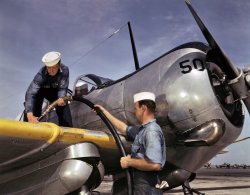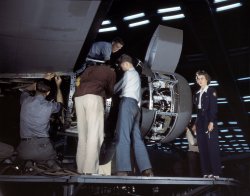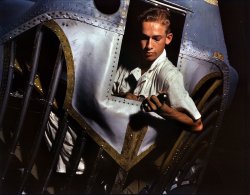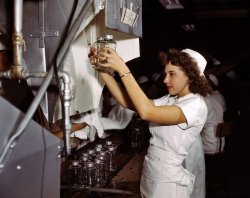
MAY CONTAIN NUTS

Search Shorpy
SHORPY ART

Framed or unframed, desk size to sofa size, printed by us in Arizona and Alabama since 2007. Explore now.
Join and Share
Ad-Free Shorpy
Shorpy is funded by you. Patreon contributors get an ad-free experience.
Learn more.

Recent comments
- Texas Flyer wanted
- Just a Year Too Soon
- WWII -- Replacing men with women at the railroad crossing.
- Yes, Icing
- You kids drive me nuts!
- NOT An Easy Job
- I wonder
- Just add window boxes
- Icing Platform?
- Indiana Harbor Belt abides
- Freezing haze
- Corrections (for those who care)
- C&NW at Nelson
- Fallen Flags
- A dangerous job made worse
- Water Stop
- Passenger trains have right of way over freights?
- Coal
- Never ceases to amaze me.
- Still chuggin' (in model form)
- Great shot
- Westerly Breeze
- For the men, a trapeze
- Tickled
- Sense of loneliness ...
- 2 cents
- Charm City
- What an Outrage
- Brighton Park
- Catenary Supports
Member Photos
The Shorpy
Print Emporium
Print Emporium
Search Shorpy
Search results -- 30 results per page
- High Octane: 1942
- ... Texas." View full size. 4x5 Kodachrome transparency by Howard R. Hollem.
Rara Avis The Curtiss-Wright CW-22 is a rare bird indeed; ... Posted by Dave - 08/10/2012 - 4:56pm -

- Consolidated Aircraft: 1942
- ... Texas." View full size. 4x5 Kodachrome transparency by Howard R. Hollem for the Odffice of War Information.
What have they done? By ... Posted by Dave - 08/10/2012 - 8:34pm -

- Elmer Pace: 1942
- ... as a sheet metal worker." 4x5 Kodachrome transparency by Howard R. Hollem. View full size.
Elmer This looks like a re-work of a ... Posted by Dave - 08/30/2012 - 3:29pm -

- Hot Rivalries: 1942
- ... shop." View full size. 5x7 nitrate negative by Howard R. Hollem for the Office of Emergency Management.
Ball size The bowling ... Posted by Dave - 01/07/2008 - 7:31pm -
![Hot Rivalries: 1942 January 1942. Bantam, Connecticut. "In the basement of the town firehouse is the bowling alley, revenue from which helps to support the town's volunteer fire companies. Each night is alloted to a specific group, and there are several hot rivalries. Among the women shown here is Mrs. Winfield Peterson, whose husband is foreman of the Warren McArthur experimental shop." View full size. 5x7 nitrate negative by Howard R. Hollem for the Office of Emergency Management.
Ball sizeThe bowling balls pictured seem smaller than today's?
[Those are duckpin balls. No holes. - Dave]
Duckpins or candlepinsFrom the size of the balls I'd guess they're engaging in duckpin or candlepin bowling. These types of bowling use relatively small balls without finger holes.
Also five-pinThat's also the size of the ball in five-pin bowling, but that game is exclusively Canadian.
Bowling DressI thought it was interesting that every one of these women was bowling in a skirt or dress. How things have changed! Already by my childhood 25 years later, all these women would have been wearing pants.
Interesting sheenon Mrs. Peterson's leading leg, perhaps indicating nylon rationing had not yet made its way to her neighborhood. Or, maybe, she had been saving a pair for special times: like this one!
[Or they might be cotton stockings, a nylon substitute that was the subject of about a dozen OWI photos. - Dave]
Re: ConnecticutConnecticut is a lingering stronghold of duckpin bowling. This appears to be that game.
Virginia is for lovers...........of duckpin bowling as well. I grew up in the Hampton Roads area of southeastern Virginia, from the late 50s until I left in 1977 with my new husband of just one year (of marriage, not age, before anyone else comments), right after he got out of the Air Force, having been stationed at Langley AFB for his entire enlistment.
Duckpin bowling was a major force in bowling competition when I was a little girl, and my dad taught me how to bowl in duckpins because the smaller duckpin balls were/are easier to handle by smaller children's hands. I got pretty good at it too. Adult leagues were going strong then, and it was amazing to me to watch the men in the men's and mixed leagues fire those little balls down the alleys like rifle shot at the short, squatty pins waiting at the other end!
It was still quite popular when I left the area for the "Great Midwaste" in 1977, to accompany my husband to his home territory. I haven't heard anything to the contrary since then about it still being quite popular.
(The Gallery, Howard Hollem, Small Towns, Sports)](https://www.shorpy.com/files/images/8e10831u.thumbnail.jpg)
- Wright Whirlwind: 1942
- ... shop. View full size. 4x5 Kodachrome transparency by Howard R. Hollem.
My God. I'm sitting here looking at this beautiful woman, and ... Posted by Dave - 08/09/2012 - 12:34pm -
![Wright Whirlwind: 1942 August 1942. Mechanic Mary Josephine Farley works on a Wright Whirlwind motor in the Corpus Christi, Texas, Naval Air Base assembly and repairs shop. View full size. 4x5 Kodachrome transparency by Howard R. Hollem.
My God.I'm sitting here looking at this beautiful woman, and then I realise ... 65 years ago.
Older than my motherYeah I'm 51 and whenever I look at these beautiful women I have to keep reminding myself that they were all born before my 79-year-old mother.
There's something about them though that makes them seem more in synch with our times than the women of say a decade later. Don't know what it is.
Mary JosephineThis is Joe Manning, of the Lewis Hine Project. I found this in the Archival Collection at Texas Woman’s University.
“Mary Josephine Farley Tilton, Letters, 1943-1944, 5 folders. Native of Aransas Pass, Texas. Worked as an engine mechanic and Link trainer instructor during World War II, then joined the Women Air Force Service Pilots (WASP), class 43-W-4. Later was commissioned in the Air Force. Served in Germany during the Korean War. Graduated in 1965 from Midwestern University with a B.S. Degree in Elementary Education and became a teacher. Letters (all photocopies), written to her family, document Tilton's experiences as a WASP trainee at Avenger Field Sweetwater, Texas, and a ferry pilot based at Love Field, Dallas, Texas. Also includes news articles and a copy of "The Flying V," newsletter of Love Field's ferrying group and a color copy of photograph [1943 or 1944]. Gift of Mary Josephine Tilton, 1995.
Mary JosephineThis touching photograph is quite similar to a painting by Norman Rockwell.
“Photography takes an instant out of time, altering life by holding it still.” Dorothea Lange
"65 years ago"Makes you want to go find a DeLorean and a flux capacitor.
Mary Josephine FarleyI am uploading a photo of her in her WASP uniform taken in 1943.
[Thank you, whoever you are! - Dave]
ColourizationInteresting with all the comments on colourization, that here is another colourized shot.
My first job in a photo studio was making prints for the artist downstairs to colourize. We would make a black and white print, and then "sepia tone" it (boy, that smelled). The sepia would add the warm tones to areas not painted. On the back of the print we would write all the colours to be used -- "complexion," "hair colour," "eye colour," "misc." She would then use transparent dyes to add the colour and varnish over it (or "fixative" in the later years).
(The Gallery, Kodachromes, Aviation, Howard Hollem, WW2)](https://www.shorpy.com/files/images/1a34879u_0.thumbnail.jpg)
- Lucille Mazurek: 1943
- ... View full size. 4x5 Kodachrome transparency by Howard R. Hollem for the Office of War Information.
Penny for Your Thoughts I ... Posted by Dave - 08/30/2012 - 2:01pm -
![Lucille Mazurek: 1943 February 1943. Lucille Mazurek, age 29, ex-housewife, husband going into the service. Working at the Heil and Co. factory in Milwaukee on blackout lamps to be used on Air Force gasoline trailers. View full size. 4x5 Kodachrome transparency by Howard R. Hollem for the Office of War Information.
Penny for Your ThoughtsI would *love* to know what the lady in the corner is thinking:
"That redheaded vixen and her damn lipstick... God, I hate her..."
Electric?Most curious...I'd think that these would be electric lamps, but can't figure why they'd have pipe/tubing fittings on them. Any ideas?
And, Mrs. Mazurek is certainly beautiful.
Blackout lightsBeen doing a little online research and have some basics. A blackout light generally put out a rectangular beam of light smaller than what a regular headlight would. In many of the examples I've seen online there was a sort of shield at the top of the rectangular beam that would keep light from spreading upward, and being visible to aircraft overhead. Some wartime jeeps had blackout lights under the regular headlights, but some models - probably made early on - had a single blackout light mounted on the driver's side fender. Presumably most military vehicles hadt to be similarly retrofitted with blackout lights. I'm just guessing, but the tubes look to be designed to protect the wiring of the retrofitted lights from water or other environmental damage from being exposed, and (probably more important on a gasoline trailer) to eliminate the possibility of sparking.
Explosion-proof blackout lampsI believe the conduit (tubing & fittings) was used to house the wiring and provide an explosion-proof lamp assembly. The sealed lamp wiring was necessary to prevent any potential internal ignition (such as an electrical spark) from escaping to the outside atmosphere, which for a gasoline trailer could contain explosive gas fumes.
Here is a web page that describes military blackout lamps and includes some photos.
Mike_G
Blackout lamp?Ok, what is a blackout lamp? I imagine it is something used during blackouts, but what is it? A light with a red lens?
hmmm... the tight sweater probably didn't hurt her employment opportunities.
Blackout lampsVehicles hauling inflammable liquids typically had the wiring sealing inside metallic tubing to prevent a loose connection from arcing and igniting fumes.
Hmmm...Quarter after five..Must be the second shift. Anyway, my guess to Lonestar's question is that since these are blackout lamps for a gasoline trailer, the copper tubing could be used as an electric wire conduit to reduce the chance of electric sparks-copper used because it is a non-sparking metal when struck.
And to robcat2075 and Jason Martens: Y'all be careful now, that Ms Lucille looks like an Irish lass with that red hair, and you wouldn't want to go and get her mad at you...she looks like she could be a handful.
Not the Air Force yetNot to be too picky, but the USAF wasn't formed until 1947. That really should read "Air Corps gasoline trailers".
[Not quite. "Air Force" was short for Army Air Forces, the name of the flying service from 1941 to 1947. Before 1941 it was the Army Air Corps. - Dave]
Heil and CompanyIt appears that Heil and Company started in Milwaukee in 1901 and is still in business.
http://www.heiltrailer.com/history.aspx
[Thanks Jack! If you signed up for a user account and then logged in, your comments would appear right away. - Dave]
In the 1940sEvery woman was lovely and graceful and every man was handsome and dashing.
Lucille Mazurek 1913-1991Mrs. Mazurek passed away in Milwaukee in 1991 according to the SSDI.
She certainly was a beautiful woman.
No wedding ring.No wedding ring. I wonder if they were required to remove them when working or is the photo reversed?
[As we can tell from Lucille's ID badge and the writing on the metal parts, the photo is not reversed. - Dave]
No rings allowedMost factories had rules against too much jewelry, but in this case, it may have interfered with her work - she has a ring line on her finger, so I guess she took it off when working. A lot of gold bands back then were softer alloys, like 24-carat, than a lot of bands nowadays, too, so maybe she didn't want it marked up or abused.
Re: No rings allowedThe lady's wedding ring could have been made from no softer than 18kt gold, not 24kt gold. Pure gold, as in 24kt gold, was entirely too soft to be made into wedding rings, or most all other forms of jewelry, which is why it is alloyed with other metals. This improves the strength and wearability of gold jewelry, as well as the working characteristics while being formed into jewelry. It also increases the affordability of the wedding rings, as pure gold would have been much too expensive to be affordable by most people.
Most common alloy used for wedding rings was, and still is, 14kt, as it provides the best characteristics of affordability, durability and workability. During the war years, gold wedding rings were in both high demand and decreased availability, and platinum was not available at all due to its requirements for the war industry in electronic devices. White gold was the most usual substitute, while palladium filled in some of that gap.
(The Gallery, Kodachromes, Factories, Howard Hollem, Milwaukee, WW2)](https://www.shorpy.com/files/images/1a34977u_0.thumbnail.jpg)
- Ordnance Mate Waller: 1942
- ... mate." View full size. Kodachrome transparency by Howard Hollem.
Possibly.. This may be Jesse R. Waller born 22 Sep 1918 and died 16 Sep 1983 in Virginia. If so, he worked ... Posted by Dave - 07/22/2012 - 12:43pm -
![Ordnance Mate Waller: 1942 August 1942, Corpus Christi, Texas: "It's an intricate operation, installing a 30-caliber machine gun in a Navy PBY plane, but not too tricky for Jesse Rhodes Waller. He's a Georgia man who's been in the Navy 5-1/2 years. At the Naval Air Base he sees that the flying ships are kept in tip-top shape. Waller is an aviation ordnance mate." View full size. Kodachrome transparency by Howard Hollem.
Possibly..This may be Jesse R. Waller born 22 Sep 1918 and died 16 Sep 1983 in Virginia. If so, he worked on railroads after the service.
hide that one from the marketers...... or they'll photoshop "the new fragrance by XYZ" on the side ;-(
That's one hell of a cool picture, right there!
White socks?White socks, penny loafers, flying helmet and goggles just to install a gun? Me thinks the photographer didn't know what the military worn when he dressed the "model".
[Jesse Waller was a Navy ordnance mate stationed at the Corpus Christi naval air base. The photo was posed as a study for a recruiting poster. - Dave]
Why is Jessie wearing pennieWhy is Jessie wearing pennie loafers?
[We might also ask why Jesse is wearing penny loafers.]
penny loafersActually these are not penny loafers. He is wearing a pair of black buckle strap oxfords similar to an optional shoe that could be worn by army air force officers. I have not seen this shoe in black before but its probably something a naval aviator could have worn. Jesse is also wearing standard navy issue blue denim trousers and chambray work shirt along with a load carrying equipment belt.
However...
The M-450 navy summer flight helmet(with added electric headphone receivers) and 6530 flying goggles is certainly not something he would be wearing to maintain an aircraft.
-bgb
Jesse Rhodes WallerWhen I first looked at this picture I couldn't believe Jesse looked old enough to have been in the Navy 5-1/2 years by 1942. But I have known guys who kept their boyish faces well into the 30s, including a former college roommate who looked essentially the same 16 yrs after we got out of college.
So, the suggested birth date of September 1918 would have made Jesse almost 24 at the time this picture was taken and as he'd turned 18 in 1936, he'd have had time for 5-1/2 years in the Navy as well as the Great Depression to motivate him to join. Remember, that to most people in the US, WWII was not yet seen as inevitable in 1936. In fact, most in the US in the late 1930s strongly hoped to stay out of another war even if one did occur.
We have a believable age and a youthful model--great for an enlistment poster. As for the shoes, they are indeed buckle strap--I took the photo into my photo program and blew it up and lightened it enough to see the buckle on the foot that's still on the concrete. Likewise the toe area of the other shoe is too tapered to be a penny loafer.
As for the white socks, perhaps they were the absorbent type as we wear today, a real boon for an active man in hot leather shoes in the steamy August climate of Corpus Christi, TX.
While the goggles and helmet would not have been worn by a maintenance mechanic, there is an explanation for that, also. There are two companion pictures to this one showing Jesse "trying out" the newly installed machine gun and he has both the helmet and goggles on as you would expect. Here and here.
There's no evidence he actually fired the gun but he's got the right "look" for it in this other photo, I think.
There were many other photos taken of the base, other military and civilian personnel, and of Corpus Christi generally at the same time. Most are not color, but a surprising number for that time are.
One other item about him turned up in the small search I did: Two months after this picture was taken young Jesse and his wife had a baby girl they named Beverly Carolyn (or perhaps the other way around.) She could well be living today, as she'd only be about 66.
So the Jesse R Waller mentioned by another poster who passed away in Virginia in 1983 may very well be this man. The dates certainly fit.
Excellent photo and it could have made a powerful recruiting poster indeed.
High caliber photo but low caliber gunBy the time of this photo it was quite obvious to the U.S. military that a .30 caliber machine gun was inadequate for attacking enemy aircraft or, in the case of this PBY, for defense. Japanese fighters had guns as large as 20 millimeter (and sometimes bigger than that), and Japanese machine guns that fired .51 caliber (by our measure) came along during World War Two. Equipping U.S. fighters with as many as eight "fifties" created a fearsome opponent; other Allied aircraft were fitted with multiple guns of that size and cannon, too. Among heavy bombers, the aptly-named B-17 Flying Fortress eventually had thirteen .50 caliber guns. (My Uncle Andrew was a B-17 tail gunner.)
Here's a comparison of ammunition sizes.
Stylish Safety That heavy belt he's wearing has straps on either side for attaching to his gun mount, kept the gunner from being tossed around by the pilot's evasive maneuvers and steep banked turns. There were an awful lot of sharp and pointy parts on those highly functional military aircraft, I've got the scars to prove it.
(The Gallery, Aviation, Howard Hollem, WW2)](https://www.shorpy.com/files/images/1a34894u.thumbnail.jpg)
- Grace Kruger: 1942
- ... clerk, took his place." 4x5 Kodachrome transparency by Howard R. Hollem for the OWI. View full size.
Glass bottles Seems strange ... Posted by Dave - 08/05/2012 - 10:55am -
























